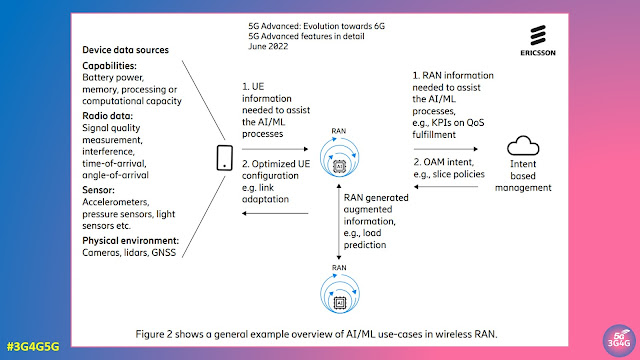We have looked at different approaches in this blog and the 3G4G website on reducing the power consumption (see related posts below). In a blog post some months back, Huawei highlighted how 5G can improve the battery life of UE. The blog post mentioned four approaches, we have looked at three of them on various blogs.
The following is from the blog post:
RRC_INACTIVE State
A UE can access network services only if it establishes a radio resource control (RRC) connection with the base station. In legacy RATs, a UE is either in the RRC_CONNECTED state (it has an RRC connection) or the RRC_IDLE state (it does not have an RRC connection). However, transitioning from the RRC_IDLE state to the RRC_CONNECTED state takes a long time, so it cannot meet the low latency requirement of some 5G services. But a UE cannot just stay in the RRC_CONNECTED state because this will consume much more UE power.
To solve this problem, 5G introduces the RRC_INACTIVE state, where the RRC connection is released but the UE context is retained (called RRC Release with Suspend), so an RRC connection can be quickly resumed when needed. This way, a UE in the RRC_INACTIVE state can access low-latency services whenever needed but consume the same amount of power as it does in the RRC_IDLE state.
DRX + WUS
Discontinuous reception (DRX) enables a UE in the RRC_CONNECTED state to periodically, instead of constantly, monitor the physical downlink control channel (PDCCH) to save power. To meet the requirements of different UE services, both short and long DRX cycles can be configured for a UE. However, when to wake up is determined by the predefined cycle, so the UE might wake up unnecessarily when there is no data scheduled.
Is there a way for a UE to wake up only when it needs to? Wake-up Signal (WUS) proposed in Release 16 is the answer. This signal can be sent before the next On Duration period (during which the UE monitors the PDCCH) so that the UE wakes up only when it receives this signal from the network. Because the length of a WUS is shorter than the On Duration Timer, using WUS to wake up a UE saves more power than using only DRX.
BWP Adaptation
In theory, working on a larger bandwidth consumes more UE power. 5G provides large bandwidths, but it is unnecessary for a UE to always work on large bandwidth. For example, if you play online mobile games on a UE, only 10 MHz of bandwidth is needed for 87% of the data transmission time. As such, Bandwidth Part (BWP) is proposed in 5G to enable UEs to work on narrower bandwidths without sacrificing user experience.
BWP adaptation enables the base station to dynamically switch between BWPs based on the UE’s traffic volume. When the traffic volume is large, a UE can work on a wide BWP, and when the traffic volume is small, the UE can work on a narrow one. BWP switching can be performed based on the downlink control information (DCI) and RRC reconfiguration messages. This ensures that a UE always works on a bandwidth that supports the traffic volume but does not consume too much power.
Maximum MIMO Layers Reduction
According to 3GPP specifications, the number of receive and transmit antennas used by a UE cannot be fewer than the maximum number of MIMO layers in the downlink and uplink, respectively. For example, when a maximum of four downlink MIMO layers are configured for a UE, the UE must enable at least four receive antennas to receive data. Therefore, if the maximum number of MIMO layers can be reduced, the UE does not have to activate as many antennas, reducing power consumption.
This can be achieved in 5G because the number of MIMO layers can be re-configured based on assistance information from UEs. After receiving a request to reduce the number of MIMO layers from a UE, the base station configures fewer MIMO layers for the UE through an RRC reconfiguration message. In this way, the UE can deactivate some antennas to save power.
T-Mobile added more cell sleep profiles (or this is just the first time i noticed it). L2100 is now turned off at night when the cell load is low. After 6am it's back on everywhere. When you load the cell it will also come back online.
— Jeffrey | Antennekaart.nl (@antennekaart) September 26, 2022
Pretty significant reduction of power use. pic.twitter.com/oDYhyLeQLw
Power consumption in the networks and the devices is a real challenge. While the battery capacity and charging speeds are increasing, it is also important to find ways to optimise the signalling parameters, etc. One such approach can be seen in the tweet above regarding regarding T-Mobile in The Netherlands, selectively switching off a carrier in the night and switching it back when the cell starts loading or in the morning.
We will see lot more innovations and optimisations to dynamically update the technologies, parameters, optimisations to ensure power savings wherever possible.
Related Posts:
- 3G4G: What is a User Equipment (UE)?
- The 3G4G Blog: A Technical Introduction to 5G NR RRC Inactive State
- Connectivity Technology Blog: InterDigital’s 6G Vision of “Zero-energy” (ZE) air-interface designs
- The 3G4G Blog: Bandwidth Part (BWP) in 5G New Radio (NR)
- Telecoms Infrastructure Blog: Huawei Explains Antennas and Radomes
- The 3G4G Blog: What is RF Front-End (RFFE) and why is it so Important?
- The 3G4G Blog: Reducing 5G Device Power Consumption Using Connected-mode Discontinuous Reception (C-DRX)
- The 3G4G Blog: Energy Consumption in Mobile Networks and RAN Power Saving Schemes
- The 3G4G Blog: Smartphone Batteries Round-up: Technology, Charging & Recycling
- The 3G4G Blog: The Futuristic Concept of 'Smart & Intelligent' Batteries





























